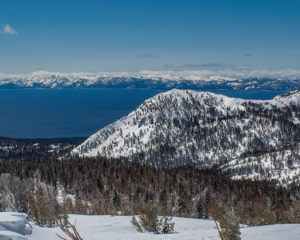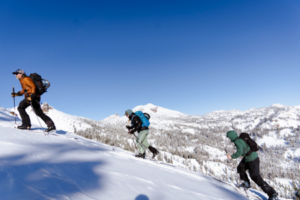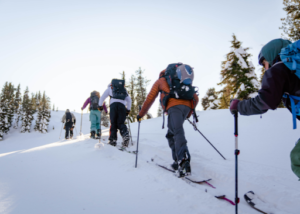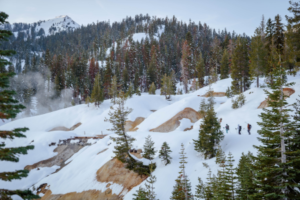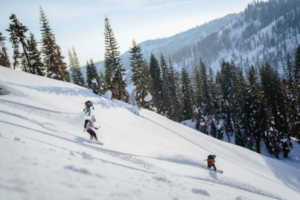Lake Tahoe is the largest alpine lake in all of North America, sitting at an elevation of 6,225’. It is 22 miles long, has 75 miles of shoreline, and is 1,645 feet deep. It’s the second deepest lake in America, just after Crater Lake in Oregon which is 1,949 feet deep, and it is the 11th deepest lake in the world. The amount of water in the lake (39 trillion gallons) is enough to supply every person in the US with 50 gallons of water every day for five years.
The vibrant, turquoise blue waters of the lake get their color from the amount of algae present. The water is so clear that in some areas, objects can be seen at over 70 feet deep. One reason for the clarity, is that 40 percent of the precipitation falling on the Tahoe Lake Basin, falls directly onto the water. The rest of the precipitation is filtered through marshes and meadows before draining into the lake. Lake Tahoe is 99.994% pure water, making it one of the most pure bodies of water in the world.
- Lake Tahoe
- Skinning up
- and up!
The lake gets its name from the Washoe Tribe of Native Americans that inhabited the lake for over 10,000 years. Tahoe means “big water” in Washo. Native Americans lived a somewhat secluded existence here until the lake was “found” by white men in 1844. The discovery went mostly unnoticed for years until Comstock Lode was found in Virginia City, Nevada. In the 1860s, Tahoe became a commercial hub because of the silver mines and railroads that were spreading out west. Because of the mining at Comstock, large-scale deforestation took place in the Tahoe Basin. The estimations of how much forest the Basin lost during this time are as high as 80%.
Over the next century, conservationists worked hard to protect Lake Tahoe. From 1912-1918, they tried to designate the Tahoe Basin as a national park, but they did not succeed. As pressures to develop the beautiful area increased in the 40s and 50s, a group was created called the League to Save Lake Tahoe in 1957. The League has been influential and imperative to the protection of the lake. They formed the Tahoe Regional Planning Agency (TRPA) which is a congressionally- approved agreement between California and Nevada to create environmental goals and take necessary actions to achieve and maintain those goals.
- Granite patches on the approach.
- Riding deep Tahoe pow!
We’ve talked a little about the history of the lake, but the story wouldn’t be complete without a discussion of the epic skiing that has taken place near the shores. It is said that the first people in the world to race competitively on skis were California gold miners. Miners started racing on skis during the Gold Rush in the early 1850s. The Lake Tahoe and Auburn ski clubs were early supporters and promoters of competition skiing. On Donner Summit, the Sugar Bowl was one of the first destination ski resorts in the country.
A man named Charles Nelson taught his friends how to ski in order to get around and have fun in the deep pow. He taught them how to make 7-12 foot long wooden boards that they shaped into skis and then sold for $6 in gold. The first legit, organized ski race championship in the world took place on February 15, 1867 in La Porte. The winner claimed a massive prize of $600.
In 1928, just a mile from the Tahoe Tavern at Lake Tahoe, an Olympic- size ski hill was built by a hired Norwegian man named Lars Haugen. Tryouts for the 1932 Winter Olympics were held here. The jump was named Granlibakken and was used and managed by the Lake Tahoe Ski Club.
The 30s brought huge changes as more and more people in the area began skiing and downhill or cross country racing competitively. The Southern Pacific Railway developed the Sugar Bowl, one of the first ski areas in the West. The 50s saw a dramatic increase in infrastructure that supported skiing and increased the number of people coming to the area. Today, people still flock to Tahoe to enjoy the sun and awesome pow. With crazy tours available around the state, it’s nice for there to be an option when the day calls for a light tour for one reason or another, that’s one thing that makes this book such a winner. The Light Tours of Lake Tahoe make for an incredible opportunity to explore some of the majestic wonder that this area has to offer.
For the Light Tours of Tahoe ski atlas, we identified many of the prime routes in this region that meet these criteria. For the places in our book where the skier might encounter a small, limited amount of avalanche terrain, we make a point to draw attention to it and describe it for the reader. Choosing to ski light tours doesn’t mean that you should venture out unprepared. It’s still paramount that you and your ski partners have avalanche training and are well equipped and knowledgeable.
Watching mounds of snow pile up on the ground can be exciting and intimidating for many backcountry enthusiasts. Many are eager to enjoy these spoils while they’re fresh, but the serious reality of avalanche risk can steer many away from journeying into the backcountry. The beauty of light tours is that they provide an alternative to your more challenging routes while still delivering delightful turns to those that are willing to sacrifice a greater rush of adrenaline for a lower risk option. Let’s say you’re looking to test out some of your new AT gear, or you’re heading out with a new ski partner, or a ton of fresh powder just fell and avalanche risk is high where you often ski; light tours serve as the perfect option for accomplishing any of these tasks. They may not suit the prototypical “instagram-worthy” experience that garners social media attention, but at the end of the day, no amount of likes is as valuable as one’s life.

